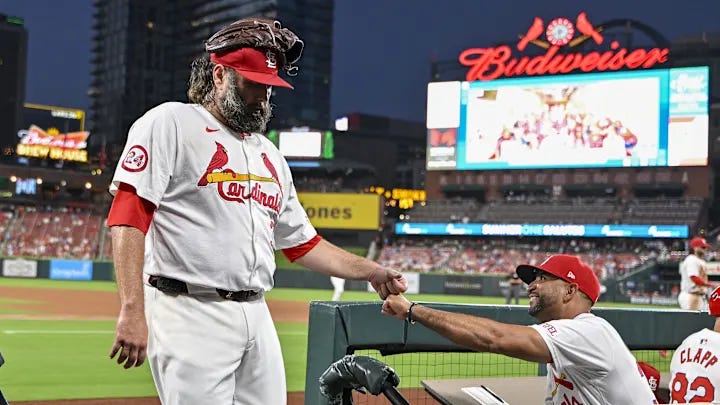Cardinals confirm downscale method by declining options on three pitchers
It has officially begun.
In past offseasons, it would be a wise assumption that the St. Louis Cardinals would exercise the option on an aging yet still durable pitcher like Lance Lynn or Kyle Gibson. After all, they were both what the team hoped for in 2024, putting up stats that helped a struggling rotation find its footing and kept the team in contention until September. Keeping at least one of them would be a patented Cardinal front office move. It is those moves that are slowly going the way of the dodo bird.
The Cardinal Way is changing. Today, the team didn’t waste a single day in declining the options on Lynn, Gibson, and Keynan Middleton. The latter pitcher spent the entire year on the injury list, quenching the hype of a strong middle reliever arriving to St. Louis. He’s one of those acquisitions who only wore the jersey theoretically. All of them will pitch elsewhere next year. I can’t imagine Lynn or Gibson taking less money than their option amounts, and it’s a first big step in changing their ways.
Wasting $30 million on three pitchers who don’t make you a playoff team or a particularly large amount of money on their own aren’t useful for a team in St. Louis’s state.
While I’m a longtime Lance fan, it would be wiser for him to contend elsewhere and for the team to give his spot to Michael McGreevy. It’s a move that trades a $12 million arm for a $550k arm, and the results should match. If the team didn’t already have two financial anchors in Steven Matz and Miles Mikolas, there’s a world where Gibson could be retained, but not if you’re paying $10-12 million for an at-best 4.00 earned run average. It would be wiser to see if Gordon Graceffo wants a taste of the rotation, or at least some spring training contention. It’s not a competition if you have guaranteed salary headed to five pitchers before the new year, which is what the team would have looked like after retaining Lynn and Gibson.
Now, Tink Hence can get a whiff of the action, and try to pitch his way into a roster or rotation spot. While it’s not likely in 2025, the path is getting clearer. I’d rather trade and pay Mikolas or Matz’s salary to another team than see them have another shot at 20 starts and/or a 4.75 ERA. If you have to pay another team to take them off your hands, do it with one of them instead of Nolan Arenado. Unless another team pays a healthy chunk of his salary or he demands a trade, I hang onto him and not pay another team to enjoy his comeback season. Then again, he could be next out the door. I can’t imagine he’s happy with the team’s performance, front office and on the field, after being sold a bill of goods to remove his opt-out contract options. But moving him and paying more than half of his salary isn’t as wise as one would initially think. Mikolas heading elsewhere would alleviate a spot for a young starter. Maybe that’s next.
The key is that change is already happening, and the ink is barely dry on the Los Angeles Dodgers’ first full season World Series title in decades. They didn’t just do it by spending large amounts of money; the Angels tried that and failed. The Dodgers built that ship by drafting and developing players that filled in the needs that a star like Freddie Freeman and Mookie Betts couldn’t do. They needed a Tommy Edman and Max Muncy to finish the push.
The Cardinals have spent a lot of money to win very little of the past decade, so their work begins as ex-Cards like Edman and Jack Flaherty enjoy the promised land. It’s only promised to teams who operate on the field and in the office. It’s only promised to teams that are wiser than a six year old.
It was wise to cut ties with Lynn, Gibson, and Middleton. Good step. What happens next, and how the roster comes together after these and future departures, will be the next step. I still want to know why John Mozeliak has a job here, but we’ll answer that conundrum tomorrow.




